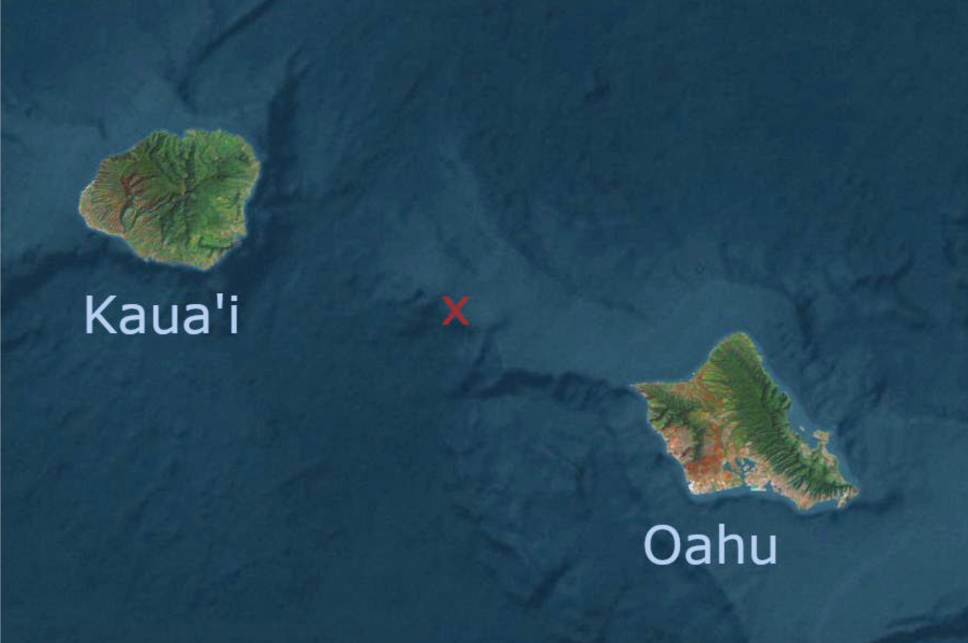

Students will construct a simple model for the temperature at a specific place, then use observational data at that location to test their model for accuracy.
NOTE: Scientists call this process of comparing the predictions from a model with actual observations “model validation”. After students validate their model by comparing it with observations, have them discuss how they might improve their model to match observations more closely.
Begin asking your students to imagine that they own a tour boat company in Hawai’i that takes customers SCUBA diving, whale watching, or deep-sea fishing. There’s a good spot in between the islands of O`ahu and Kaua’i for those activities. Explain that as the boat operator they might want to know what the weather is likely to be at that spot, to tell their customers how to dress before the boat leaves port. There are weather stations on O`ahu and Kaua`i, but not at the spot in the ocean in between. Discuss with students how they might predict the weather at that spot. Tell them that they will make a simple model to do that.
Show students Figure 3, a map of the Hawai`ian islands of Kaua`i and O`ahu, with the location of interest between the islands marked with an “X”. Let them know that weather stations on Kaua`i and O`ahu record the temperature 24 hours a day. Their goal is to make a simple model of the temperature at location “X”. Sometimes ships pass near this location and measure the temperature at that spot as they pass by. Tell students to use data from the ships to make a simple model of the temperature at the “X” for times when there isn’t a ship there to directly measure the temperature.

Figure 3: Hawai`ian Islands of Kaua`i and O`ahu
Show students Table 1, which provides temperature observations at three dates and times from the permanent weather stations on Kaua`i and O`ahu and from ships that passed near location “X”. Ask them to create a simple model for the temperature at location “X” based on these observations.
|
Date |
Time |
Temperature (°C) |
||
|
Kaua’i |
Ship |
O`ahu |
||
|
May 25 |
8 PM |
20 |
21 |
24 |
|
June 19 |
3 AM |
18 |
19 |
22 |
|
August 23 |
10 PM |
19 |
20 |
23 |
Table 1: Temperature Observations from Weather Stations and Ships
NOTE: Students should notice that for each date and time the temperature at the ship was 1 degree warmer than the temperature on Kaua`i and 3 degrees cooler than the temperature on O`ahu. There are various ways students might state their model. However they state it, their model should predict that the temperature at the “X” will be lower than the temperature on O`ahu, higher than the temperature on Kaua`i, and closer to the Kaua`i reading than to the O`ahu value.
Table 2 shows the temperature readings on Kaua`i and O`ahu every three hours for a 24-hour span. Ask your students to fill in their model’s predictions for the temperature at location “X” in the “Model” column of the table on “VES-V Observations & Model Data Lesson Worksheet #2: Hawai`ian Buoy Temperature Model”. Table 2 shows an appropriate solution for the temperature values generated by the model.
|
Time |
Temperature (°C) |
||
|
Kaua’i |
Model |
O`ahu |
|
|
3 AM |
17 |
18* |
21 |
|
6 AM |
18 |
19* |
22 |
|
9 AM |
20 |
21* |
24 |
|
Noon |
23 |
24* |
27 |
|
3 PM |
25 |
26* |
29 |
|
6 PM |
22 |
23* |
26 |
|
9 PM |
20 |
21* |
24 |
|
Midnight |
18 |
19* |
22 |
Table 2: Temperature Readings on the Islands and Model Predictions at “X” (*Values in the “Model” column show expected student responses.)
Next, let your students know that they will validate their model by comparing their model’s predictions with actual temperature observations at location “X”. Explain that model validation is the process of comparing the predictions from a model with actual observations to test how accurate the model is. If the model’s predictions match up well with the observations, the model’s validity is high and we can have confidence in its predictions. If the model’s predictions don’t match the observations, the validity is low as is our confidence in its predictions. If the validity is low, we may need to improve the model before we rely on its predictions.
Inform your students that a buoy with a weather station has been permanently installed at location “X”. It records temperatures 24 hours a day, like the weather stations on Kaua`i and O`ahu. Your students will use temperature readings from the buoy to validate their model - comparing their predictions with actual observations from the buoy. Show students Table 3 (below), which displays temperature readings from the buoy. Tell your students to copy their modeled temperature values from the table on “VES-V Observations & Model Data Lesson Worksheet #2: Hawai`ian Buoy Temperature Model” to the table on “VES-V Observations & Model Data Lesson Worksheet #3: Hawai`ian Buoy Temperature Data”. This will allow them to compare the modeled and observational values side-by-side.
|
Time |
Temperature at the Buoy (°C) |
|
3 AM |
18 |
|
6 AM |
19 |
|
9 AM |
20 |
|
Noon |
21 |
|
3 PM |
22 |
|
6 PM |
22 |
|
9 PM |
21 |
|
Midnight |
19 |
Table 3: Temperature Observations from the Buoy at the “X”
Table 4 shows the full data table that students have constructed, which includes temperature observations on Kaua`i, O`ahu, at the buoy, and the temperature predictions from the student’s model.
|
Time |
Temperature (°C) |
|||
|
Kaua`i |
Model |
Buoy |
O`ahu |
|
|
3 AM |
17 |
18* |
18 |
21 |
|
6 AM |
18 |
19* |
19 |
22 |
|
9 AM |
20 |
21* |
20 |
24 |
|
Noon |
23 |
24* |
21 |
27 |
|
3 PM |
25 |
26* |
22 |
29 |
|
6 PM |
22 |
23* |
22 |
26 |
|
9 PM |
20 |
21* |
21 |
24 |
|
Midnight |
18 |
19* |
19 |
22 |
Table 4: Temperature Model Validation and Temperature Observations (*Values in the “Model” column show expected student responses)
Ask your students to compare the values generated by their model with the observations at the buoy. Students should notice that during the night, from 9 PM to 6 AM, observations at the buoy match the predictions from the model. However, during the day from 9 AM to 6 PM, the observed temperature at the buoy is cooler than the predictions from the model.
Ask students to make a claim about the validity of their model and their confidence in it - ask them to back it up with evidence. In this example the model is reasonably valid. At its worst, the model is off by 3 or 4 degrees in the early afternoon. At its best, the model’s predictions match the observations from the buoy precisely, throughout most of the night. We could have pretty good confidence in the model’s predictions in general; with greater confidence at night than during the day.
Ask the students to discuss the possible reasons for the differences between observations and the model’s predictions.
Places on land tend to warm up and cool down more quickly than places over the ocean; the thermal inertia of the water prevents rapid heating or cooling. So, the land-based weather stations on Kaua`i and O`ahu might warm up more quickly during daylight hours when the Sun is shining than a location over water would. Since the model’s predictions were based on the observations from land-based stations on the two islands, that might cause the model’s daytime predictions to be too high.
A better model might have two parts. The existing model could be applied during the nighttime, when it has been shown to be valid. During daylight times, a modified version of the model which predicts slightly lower temperatures at location “X” would be more accurate and valid. More observations during daytime would be needed to test the validity of such a revised model.
Discussion: Remind your students they used observational data two ways in this activity. They first used a few observations from ships and the weather stations on the islands to construct their simple model. Then they used observations from the buoy to validate the predictions made by their model.